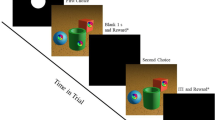Abstract
The ability to compute probability, previously shown in nonverbal infants, apes, and monkeys, was examined in three experiments with pigeons. After responding to individually presented keys in an operant chamber that delivered reinforcement with varying probabilities, pigeons chose between these keys on probe trials. Pigeons strongly preferred a 75% reinforced key over a 25% reinforced key, even when the total number of reinforcers obtained on each key was equated. When both keys delivered 50% reinforcement, pigeons showed indifference between them, even though three times more reinforcers were obtained on one key than on the other. It is suggested that computation of probability may be common to many classes of animals and may be driven by the need to forage successfully for nutritional food items, mates, and areas with a low density of predators.



Similar content being viewed by others
References
Agrillo C, Dadda M, Serena G, Bisazza A (2009) Use of number by fish. PLoS One 4:e4786
Balsam PD, Gallistel CR (2009) Temporal maps and informativeness in associative learning. Trends Neurosci 32:73–78
Bitterman ME (1965) Phyletic differences in learning. Am Psychol 20:396–410
Bullock DH, Bitterman ME (1962) Probability-matching in the pigeon. Am J Psychol 75:634–639
Cantlon JF, Brannon EM (2006) Shared system for ordering small and large numbers in monkeys and humans. Psychol Sci 17:401–406
Cantlon JF, Platt ML, Brannon EM (2009) Beyond the number domain. Trends Cogn Sci 13:83–91
Cunningham PJ, Shahan TA (2018) Suboptimal choice, reward-predictive signals, and temporal information. J Exp Psychol Anim Learn Cogn 44:1–22
Denison S, Xu F (2010) Twelve- to 14-month-old infants can predict single-event probability with large set sizes. Dev Sci 13:798–803
Denison S, Xu F (2014) The origins of probabilistic inference in human infants. Cognition 130:335–347
Denison S, Reed C, Xu F (2012) The emergence of probabilistic reasoning in very young infants: evidence from 4.5- and 6-month-olds. Dev Psychol 49:243–249
Fagen R (1987) A generalized habitat matching rule. Evol Ecol 1:5–10
Gallistel CR, Gelman R (2000) Non-verbal numerical cognition: from reals to integers. Trends Cogn Sci 4:59–65
Gallistel CR, Gibbon J (2000) Time, rate, and conditioning. Psychol Rev 107:289–344
Gipson CD, Alessandri JJ, Miller HC, Zentall TR (2009) Preference for 50% reinforcement over 75% reinforcement by pigeons. Learn Behav 37:289–298
Herrnstein RJ (1970) On the law of effect. J Exp Anal Behav 13:243–266
Herrnstein RJ (1974) Formal properties of the matching law. J Exp Anal Behav 21:159–164
Kyonka EGE, Grace RC (2008) Rapid acquisition of preference in concurrent chains when alternatives differ on multiple dimensions of reinforcement. J Exp Anal Behav 89:49–69
MacDonald HM, Roberts WA (2018) Cognitve flexibility and dual processing in pigeons: temporal Anim and contextual control of midsession reversal. J Exp Psychol Anim Behav Proc 44:149–161
Meck WH, Church RM (1983) A mode control model of counting and timing processes. J Exp Psychol Anim Behav Proc 9:320–334
Rakoczy H, Cluver A, Saucke L, Sto`ffregen N, Grabener A, Migura J, Call J (2014) Apes are intuitive statisticians. Cognition 131:60–68
Roberts WA (2010) Distance and magnitude effects in sequential number discrimination by pigeons. J Exp Psychol Anim Behav Proc 36:206–216
Roberts WA, Coughlin R, Roberts S (2000) Pigeons flexibly time or count on cue. Psychol Sci 11:218–222
Roberts WA, Strang C, Macpherson K (2015) Memory systems interaction in the pigeon: working and reference memory. J Exp Psychol Anim Learn Cogn 41:152–162
Schneider JW (1968) Effects of percentage reinforcement on choice in a concurrent chain schedule. Psychon Sci 12:211–212
Spetch ML, Dunn R (1987) Choice between reliable and unreliable outcomes: mixed percentage-reinforcement in concurrent chains. J Exp Anal Behav 47:57–72
Stagner JP, Zentall TR (2010) Suboptimal choice behavior by pigeons. Psychonom Bull Rev 17:412–416
Stephens DW, Krebs JR (1986) Foraging theory. Princeton University Press, Princeton
Tecwyn EC, Denison S, Messer EJE, Buchsbaum D (2017) Intuitive probabilistic inference in capuchin monkeys. Anim Cogn 20:243–256
Vasconcelos M, Monteiro T, Kacelnik A (2015) Irrational choice and the value of information. Sci Rep 5:13874. https://doi.org/10.1038/srep13874
Walsh V (2003) A theory of magnitude: common cortical metrics of time, space and quantity. Trends Cogn Sci 7:483–488
Whalen J, Gallistel CR, Gelman R (1999) Nonverbal counting in humans: the psychophysics of number representation. Psychol Sci 10:130–137
Xu F, Denison S (2009) Statistical inference and sensitivity to sampling in 11-month-old infants. Cognition 112:97–104
Xu F, Garcia V (2008) Intuitive statistics by 8-month-old infants. Proc Nat Acad Sci 105:5012–5015
Zentall TR (2014) Suboptimal choice by pigeons: an analog of human gambling behavior. Behav Proc 103:156–164
Zentall TR (2016) Resolving the paradox of suboptimal choice. J Exp Psychol Anim Learn Cogn 42:1–14
Zentall TR, Stagner J (2011a) Maladaptive choice behavior by pigeons: an animal analogue and possible mechanism for gambling (sub-optimal human decision-making behaviour). Proc B Bio Sci R Soc 278:1203–1208
Zentall TR, Stagner JP (2011b) Sub-optimal choice by pigeons. Failure to support the Allais paradox. Learn Mot 42:245–254
Funding
Support for this research was provided by a Discovery Grant from the Canadian Natural Sciences and Engineering Research Council to William A. Roberts (R1520A01).
Author information
Authors and Affiliations
Corresponding author
Rights and permissions
About this article
Cite this article
Roberts, W.A., MacDonald, H. & Lo, K.H. Pigeons play the percentages: computation of probability in a bird. Anim Cogn 21, 575–581 (2018). https://doi.org/10.1007/s10071-018-1192-0
Received:
Revised:
Accepted:
Published:
Issue Date:
DOI: https://doi.org/10.1007/s10071-018-1192-0




